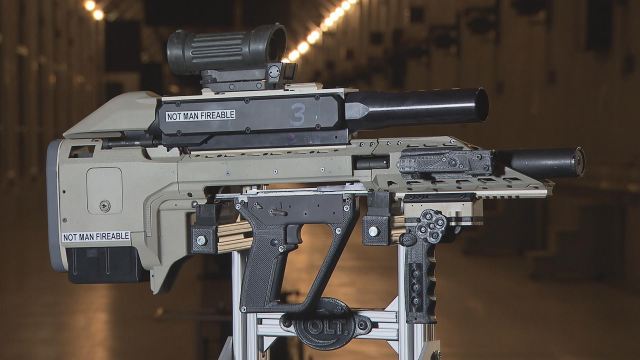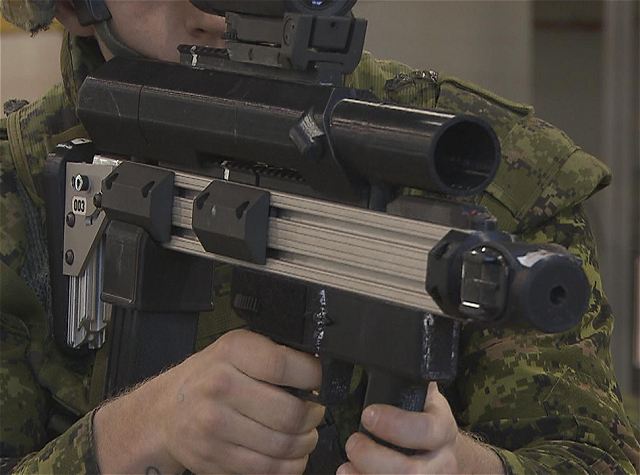Canadian armed forces and Colt have developed a new concept of assault rifle SIPES project.
|
Defense Industry & Military Equipment - SIPES assault rifle
|
|||
|
|
|||
|
|
|||
| Canadian armed forces and Colt have developed a new concept of assault rifle SIPES project. | |||
|
More firepower, improved accuracy and smart integrated accessories that connect to command and control networks are the headline features of the new integrated assault rifle concept that Defence Research and Development Canada (DRDC) and Colt Canada have developed for the Canadian Armed Forces (CAF).
|
|||
|
|
|||
 Prototype designed to be more powerful, accurate and integrated with networked add-ons for situational awareness. Photo: Jocelyn Tessier, DRDC. |
|||
|
|
|||
|
The prototype, in development since 2009 through the Soldier Integrated Precision Effects Systems (SIPES) project, includes a firing mechanism to shoot lightweight cased telescoped ammunition, a secondary effects module for increased firepower and a NATO standard power and data rail to integrate accessories like electro-optical sights and position sensors. In order to support the multi-role nature of the weapon, the prototype’s secondary effects module features the ability to install either a three round 40 mm grenade launcher, or a 12-gauge shotgun. When optimized, the integrated weapon prototype could weigh less than a C7 equipped with a M203 grenade launcher, reducing the burden on soldiers. |
|||
|
|
|||
 A Canadian Army soldier tests an early prototype of the next generation rifle. Photo: Jocelyn Tessier, DRDC. |
|||
|
|
|||
|
“In the medium term, this weapon concept represents a lethal, flexible general-purpose platform,” said Lieutenant-Colonel Serge Lapointe, from the Soldier Systems group in Director Land Requirements – Soldier Systems (DLR 5) of the Canadian Army. “It will be able to operate in all theatres of operations in the most complex terrain including urban areas, mountains, jungles, deserts and the Arctic.”
The development of the weapon prototype posed a considerable challenge. DRDC scientists analyzed advanced material technologies that could replace the metal used in heavy components. The lightweight case telescoped ammunition was tested extensively with the support of the Munitions Experimental Test Centre in Valcartier, Quebec to assess its long-term aging behaviour. Scientists also studied how to increase the rifle’s accuracy using technology that can automatically detect targets and assist with engaging them. Questions related to the sensors needed to accurately geo-locate targets for target data sharing were also investigated.How the soldier interacts with the weapon was also the subject of numerous human factor trials. Ergonomic and weapon prototype handling tests were performed by Human Systems Inc., under the supervision of DRDC scientists, with CAF soldiers from military bases in Petawawa and Edmonton. The testing was crucial to developing optimal design criteria to meet the CAF’s needs for the Small Arms Modernization project. |
|||
|
|
|||
 The prototype is under development since 2009 through the Soldier Integrated Precision Effects Systems (SIPES) project. |
|||
|
|
|||
|
In addition, lessons learned by both DRDC personnel and the CAF during their deployment in Afghanistan revealed critical elements that informed the prototype weapon development process with respect to its design and functionality.
“The results of the first phase of the project have shown that DRDC expertise can be used to provide the Canadian Armed Forces with solid scientific data so they can make more informed decisions for their major acquisition projects,” said Dr. Guy Vézina, the Director General for S&T Army, DRDC. The new weapon prototype is a promising development for the soldier of the future. The integration of electronic components will allow soldiers to generate or receive data from the command and control network. In the next phase of development, automated target detection and assisted target engagement will be the subject of an in-depth study in the Future Small Arms Research (FSAR) project. Finally, the development of the integrated weapon prototype and the continuing analysis of promising technologies should facilitate the acquisition of the next generation of small arms by the CAF. The data collected and the analyses documented so far by DRDC scientists will be used in conjunction with the data and analyses that will be generated in the FSAR project to develop the technical criteria that will form part of the statement of operational requirement documentation for the CAF Small Arms Modernization project. |
|||


























